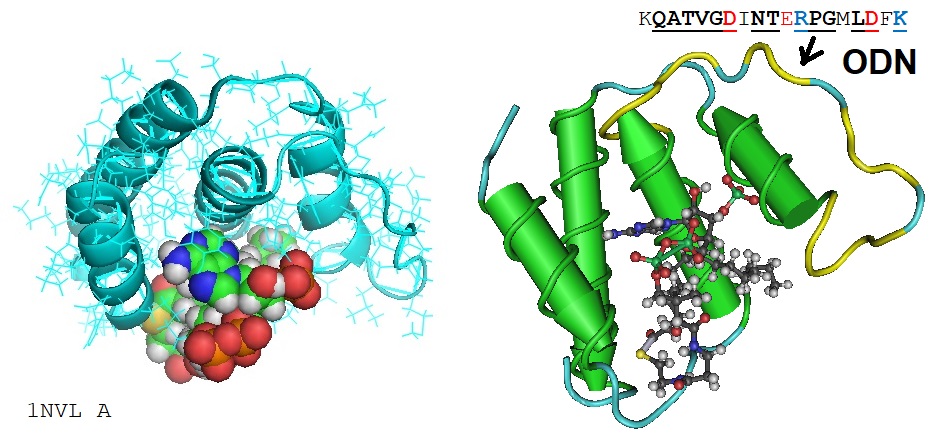The octadecaneuropeptide (ODN), QATVGDVNTDRPGLLDLK, C81H138N24O29, Mw: 1912.1 g/mol, protects both neurons and astrocytes from oxidative stress-induced cell death.
ODN is a neuropeptide similar to other neuropeptides for example, the nerve growth factor (NGF) that exhibit cytoprotective activities, and some also induce cell differentiation.
ODN is highly expressed in the developing nervous system where it has cytoprotective and antioxidant effects in cultured murine astrocytes and cerebellar granule neurons in vitro and dopaminergic neurons in vivo.
ODN is a peptide derived from diazepam-binding inhibitor. ODN is also known to reduce food intake in goldfish as well as in rodents, and possibly humans.
In humans “this gene encodes a diazepam binding inhibitor, a protein that is regulated by hormones and is involved in lipid metabolism and the displacement of beta-carbolines and benzodiazepines, which modulate signal transduction at type A gamma-aminobutyric acid receptors located in brain synapses. The protein is conserved from yeast to mammals, with the most highly conserved domain consisting of seven contiguous residues that constitute the hydrophobic binding site for medium- and long-chain acyl-Coenzyme A esters. Diazepam binding inhibitor is also known to mediate the feedback regulation of pancreatic secretion and the postprandial release of cholecystokinin, in addition to its role as a mediator in corticotropin-dependent adrenal steroidogenesis. Three pseudogenes located on chromosomes 6, 8 and 16 have been identified. Multiple transcript variants encoding different isoforms have been described for this gene. [provided by RefSeq, Jul 2008]” [Source: https://www.ncbi.nlm.nih.gov/gene/1622]
In neurodegenerative diseases such as Alzheimer’s disease, Parkinson’s disease, and multiple sclerosis by neuronal cell death is caused in part by inflammatory processes, mitochondrial alterations, and an elevation of oxidative stress. Oxidative stress induces imbalance in ROS generation, impairs cellular antioxidant defenses and can trigger both neurons and astroglial cell death via apoptosis. Astrocytes synthesize and release endozepines, a family of regulatory peptides, including ODN.

1NVL: RDC-refined NMR structure of bovine Acyl-coenzyme A Binding Protein, ACBP, in complex with palmitoyl-coenzyme A
Alignment of selected Octaneuropeptides

ODN was originally characterized as an endogenous ligand for central-type benzodiazepine receptors. ODN is known to increase intracellular calcium concentration ([Ca2+]i) in rat astroglial cells.
Recently, using a peptidomic approach, two N-terminal fragments of acyl-Co-A-binding protein were identified in yeast, a single N-terminal fragment was identified in human cells, and a number of N-terminal peptides were identified in mouse tissues along with a couple of internal peptides. In addition, ODN prevents toxicity induced by 6-hydroxydopamine in cultured rat astrocyte. Apparently ODN triggers or stimulates the endogenous antioxidant systems and the intrinsic apoptotic pathway.
Reference
Dasgupta S, Yang C, Castro LM, Tashima AK, Ferro ES, Moir RD, Willis IM, Fricker LD. Analysis of the Yeast Peptidome and Comparison with the Human Peptidome. PLoS One. 2016 Sep 29;11(9):e0163312. doi: 10.1371/journal.pone.0163312. PMID: 27685651; PMCID: PMC5042401. https://www.ncbi.nlm.nih.gov/pmc/articles/PMC5042401/
Givalois L, Grinevich V, Li S, Garcia-De-Yebenes E, Pelletier G.; The octadecaneuropeptide-induced response of corticotropin-releasing hormone messenger RNA levels is mediated by GABA(A) receptors and modulated by endogenous steroids. Neuroscience. 1998 Jul;85(2):557-67.
Hamdi Y, Kaddour H, Vaudry D, Leprince J, Zarrouk A, Hammami M, Vaudry H, Tonon MC, Amri M, Masmoudi-Kouki O. Octadecaneuropeptide ODN prevents hydrogen peroxide-induced oxidative damage of biomolecules in cultured rat astrocytes. Peptides. 2015 Sep;71:56-65. doi: 10.1016/j.peptides.2015.06.010. Epub 2015 Jul 2. Review. https://doi.org/10.1101/266379.
https://www.biorxiv.org/content/10.1101/266379v1.full
Hamdi Y, Kaddour H, Vaudry D, Bahdoudi S, Douiri S, Leprince J, Castel H, Vaudry H, Tonon MC, Amri M, Masmoudi-Kouki O.; The octadecaneuropeptide ODN protects astrocytes against hydrogen peroxide-induced apoptosis via a PKA/MAPK-dependent mechanism. PLoS One. 2012;7(8):e42498. doi: 10.1371/journal.pone.0042498. Epub 2012 Aug 21.
Kaddour H, Hamdi Y, Vaudry D, Basille M, Desrues L, Leprince J, Castel H, Vaudry H, Tonon MC, Amri M, Masmoudi-Kouki O.; The octadecaneuropeptide ODN prevents 6-hydroxydopamine-induced apoptosis of cerebellar granule neurons through a PKC-MAPK-dependent pathway. J Neurochem. 2013 May;125(4):620-33. doi: 10.1111/jnc.12140. Epub 2013 Feb 19.
Masmoudi-Kouki O, Hamdi Y, Ghouili I, Bahdoudi S, Kaddour H, Leprince J, Castel H, Vaudry H, Amri M, Vaudry D, Tonon MC.; Neuroprotection with the Endozepine Octadecaneuropeptide, ODN. Curr Pharm Des. 2018;24(33):3918-3925. doi: 10.2174/1381612824666181112111746.
Namsi A, Nury T, Khan AS, Leprince J, Vaudry D, Caccia C, Leoni V, Atanasov AG, Tonon MC, Masmoudi-Kouki O, Lizard G.;
Octadecaneuropeptide (ODN) Induces N2a Cells Differentiation through a PKA/PLC/PKC/MEK/ERK-Dependent Pathway: Incidence on Peroxisome, Mitochondria, and Lipid Profiles. Molecules. 2019 Sep 11;24(18). pii: E3310. doi: 10.3390/molecules24183310.
ODN: https://www.ncbi.nlm.nih.gov/pubmed/?term=Octadecaneuropeptide
---…---